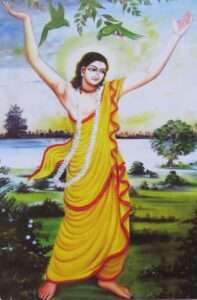Syamananda Sataka (verses 11-15)
These 101 slokas in honor of Syamananda Prabhu were written by Sri Rasikananda.
11
magnam ghora-su-dustare ‘khila-
janam samsara-varamnidhau
paravara-gamagama-vyasanitam
uddhatu-kamo gatah
krishna-prema-vahitram avirakarod
yah karnadharah svayam
sandranugraha-murtaye bhagavate
tasmai namah karshnaye
I offer my respectful obeisances to Krishnananda’s exalted son, Sri Syama-nanda. He is great mercy personified. He is the captain of the boat[1]. Desiring to rescue the people drowning in the horrible impassible ocean of repeated birth and death, he came to this world, bringing with him the wonderfully powerful boat of pure love for Lord Krishna, a boat that at once takes one to the farthest shore.
12
atha prasada-jaladhih
bhinnabhih srutibhih smriti-prabhritibhir bhrantah puranagamaih
siddhantair api krishna-bhakti-rasikah syur yat-prasada-sthirah
dura-nandanam anato ‘smi tam aham vedartha-saraspadam
trayya-gita-gunanuvadam atulanandam paresham param
He is an Ocean of Mercy.
I offer my respectful obeisances to Sri Durika Devi’s son, Sri Syamananda. He is the abode where the true meanings of all the Vedas rest. He teaches that the three Vedas[2] describe Lord Krishna’s glories. His bliss has no equal. He is the most exalted of exalted devotees. By his mercy the people bewildered by the different Vedas[3], Smriti Sastras[4], Puranas, Agamas, and other philosophies have now become devotees who taste the nectar of service to Lord Krishna.
13
vadodarka-kutarkakarkasa-
dhiyah sankhyati-sankhyonnata
vedantadhvani panthatam
upagata vaiseshikodvakra-gah
mimamsa-prabalas ca ye
vyasaninah patanjale te ‘bhavan
yasyanugraha-lesato ‘cyuta-
paras tasmai namah karshnaye
I offer my respectful obeisances to Krishnananda’s son, Sri Syamananda. By a small fragment of His mercy the hard-hearted logicians, the followers of atheistic sankhya[5], the persons who walk on the path of impersonal Vedanta[6], the crooked followers of vaisesika, and the followers of mimamsa have all become devotees of the infallible Supreme Personality of Godhead, Lord Sri Krishna.
14
vani yasya vinodini su-
vidusham govinda-vartankita
lila yasya subhankari tri-
jagatah krishnanuraga-prada
haso yasya madandhakara-
dalano nana-madandhatmanam
drishtir yasya kripavaloka-
madhura tasmai namah karshnaye
I offer my respectful obeisances to Krishnananda’s son, Sri Syamananda. Filled with news of Lord Krishna, his graceful words delight the wise. His auspicious pastimes make the three worlds[7] fall in love with Lord Krishna. His smile breaks apart the darkness that blinds the materialists. His glance is sweet with mercy.
15
sausilyena vinodayan sujanatam
manena dushtan nayan
kainkaryam parimodayan kila
balat panditya-sarair budhan
visvam krishna-rasavahena
vapusha nihsesham anandayan
sadgunyadbhuta-viryavan vijayate
ko ‘pi prabhunam prabhuh
Glory to a saintly and wonderfully powerful person, a person who is the master of masters, a person who with His saintly virtues delights the pious, a person who respectfully leads even the wicked to the path of devotional service, a person who with his great learning pleases the learned, a person with his glorious form filled with the nectar of love for Lord Krishna delights the whole world[8].
[1] There is a verse in the Srimad-Bhagavatam (1.1.22) defining the spiritual master as a “captain of the boat”: tvaḿ naḥ sandarśito dhātrā dustaraḿ nistitīrṣatām kaliḿ sattva-haraḿ puḿsāḿ karṇa-dhāra ivārṇavam. “We think that we have met Your Goodness by the will of providence, just so that we may accept you as captain of the ship for those who desire to cross the difficult ocean of Kali, which deteriorates all the good qualities of a human being.”
[2] The main Vedas are the Rig, Yajur and Sama. They are called trayi-vidya, the threefold knowledge. The forth Veda is the Atharva Veda.
[3] By Vedas it is meant the four original Vedas with the Upanisad. They are called Sruti.
[4] Smriti are the scriptures that accept the Sruti as their basis. They are the Puranas, the Vedanga, the Upapurana, the Itihasa like Maha-bharata and Ramayana, and many others.
[5] There are two sankhya: the atheist and the theist. According to the atheistic sankhya, three types of misery arise from not distinguishing prakriti from purusa. By distinguishing prakriti from purusa, the beginningless non-distinction (ignorance) is destroyed. Then prakrti has no control over purusa and the three types of misery (adhyatmika, adhibhautika, aādhidaivika) will be destroyed. This result is eternal, since it is the form of non-existence (abhava) of ignorance (since abhava is eternal). Attainment of bliss accompanies this, just as one becomes happy on getting rid of a heavy weight. Nothing can surpass this state.
[6] Those who establish that at the end of everything there is an impersonal light, the brahmajyoti.
[7] The universe is divided into three planetary systems, lower, medium and superior, or Bhuh, Bhuvah and Svah (Patala, Martya and Svarga).
[8] The Caitanya Caritamrita (Madhyalila 22.78-80) mentions twenty-six qualities of a sadhu. ““Devotees are always merciful, humble, truthful, equal to all, faultless, magnanimous, mild and clean. They are without material possessions, and they perform welfare work for everyone. They are peaceful, surrendered to Kṛṣṇa and desireless. They are indifferent to material acquisitions and are fixed in devotional service. They completely control the six bad qualities — lust, anger, greed and so forth. They eat only as much as required, and they are not inebriated. They are respectful, grave, compassionate and without false prestige. They are friendly, poetic, expert and silent.”
Srimad-Bhagavatam (3.25.21) mentions six: “The symptoms of a sādhu are that he is tolerant, merciful and friendly to all living entities. He has no enemies, he is peaceful, he abides by the scriptures, and all his characteristics are sublime.”
This is a section of the book “Syamananda, the Joy of Radharani (English)”.
To buy the complete book, click above
Post view 248 times




Leave a Reply